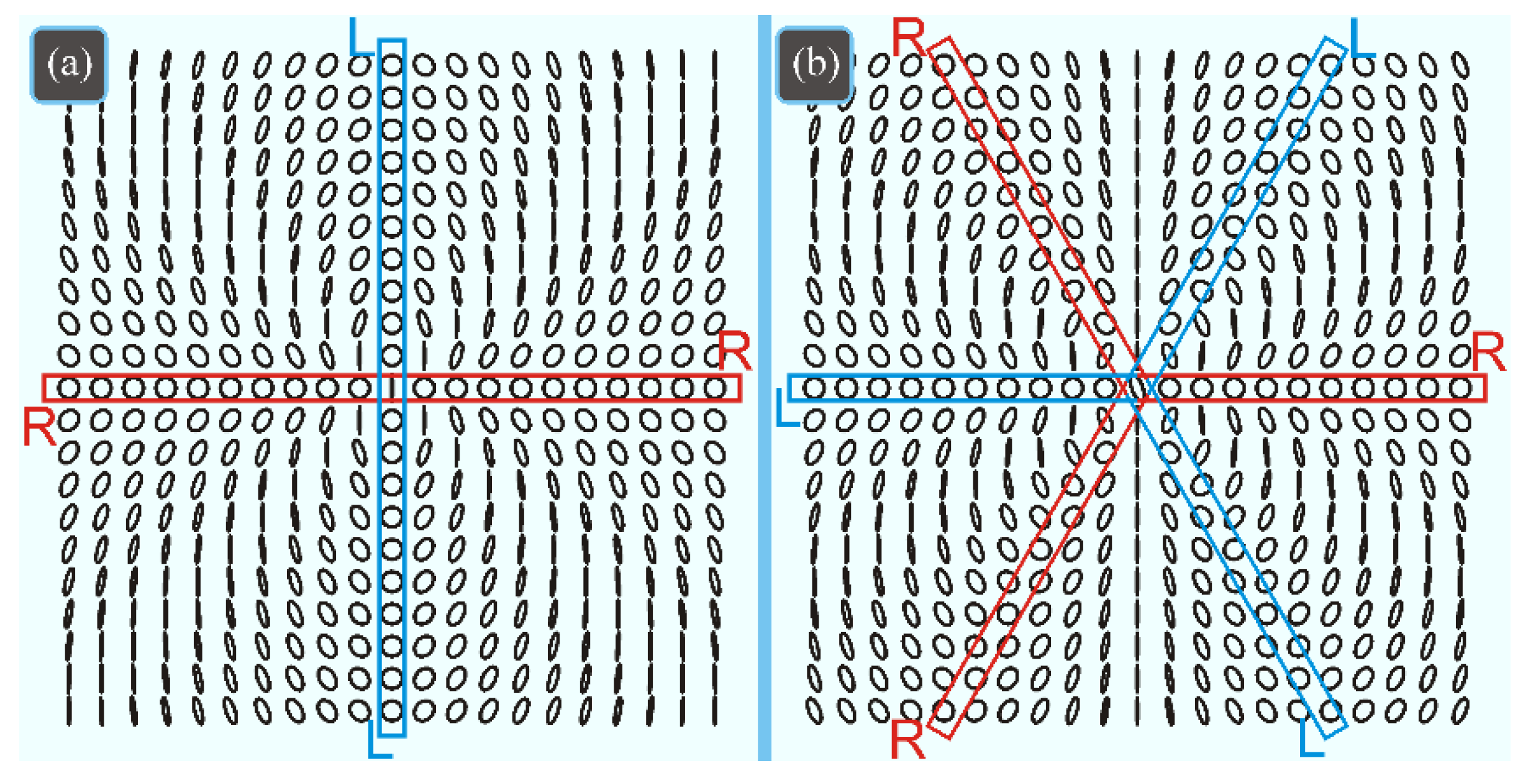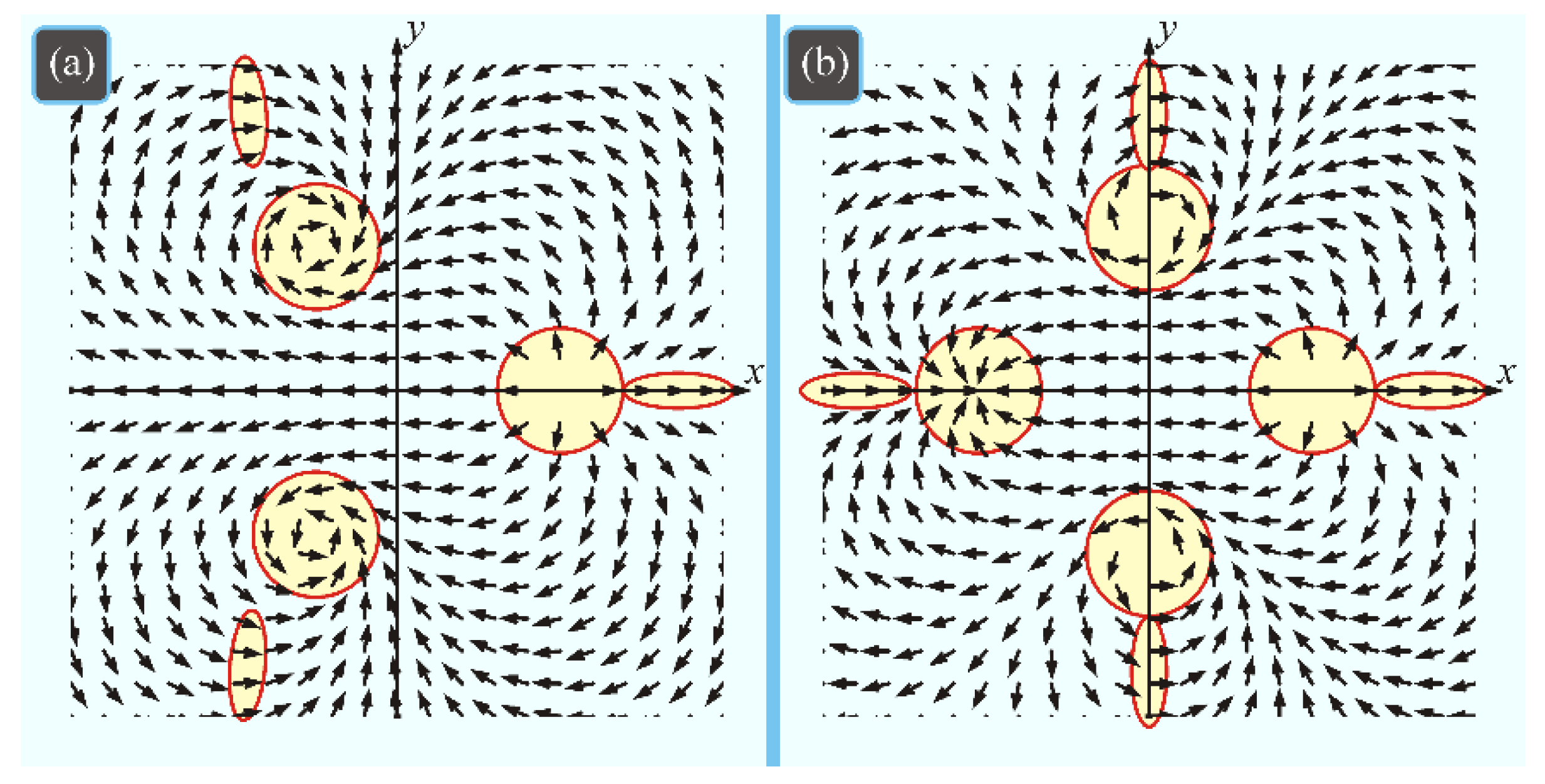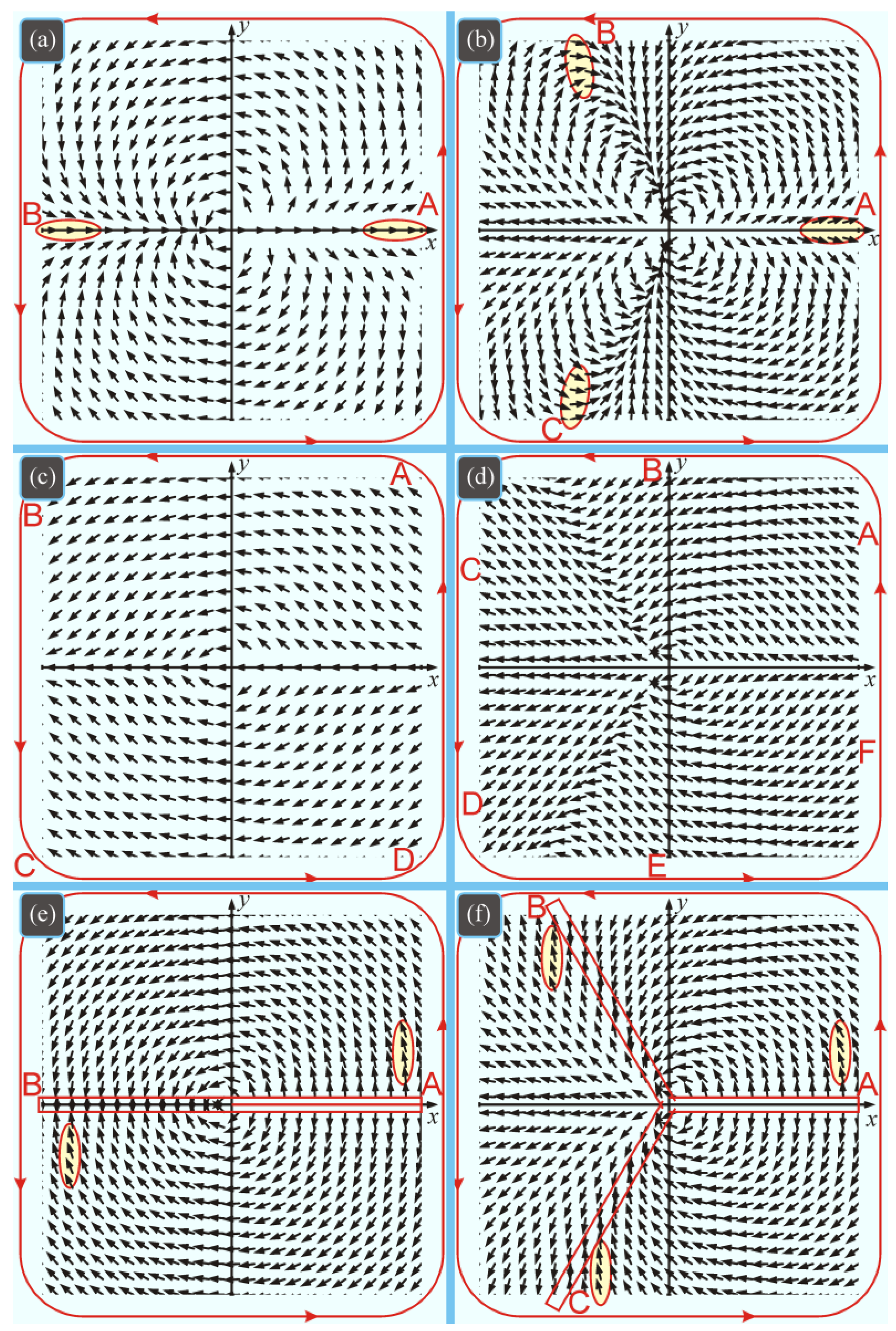Topological Charge of Light Fields with a Polarization Singularity
Abstract
:1. Introduction
2. Motivation
3. PSI for Higher-Order Cylindrical Vector Fields
3.1. Calculation of the PSI of Vector Fields
3.2. Numerical Simulation for the Cylindrical Vector Fields
4. PSI of a Generalized Varied-Order Vector Field
4.1. Calculation of the PSI for Generalized Vector Fields
4.2. Numerical Simulation of Generalized Vector Fields
5. PSI of Higher-Order Fields with Hybrid Radial-Circular and Azimuthal-Circular Polarization
5.1. Calculation of the PSI for Linearly-Circular Hybrid Field
5.2. Numerical Simulation for the Field with Hybrid Polarization
6. PSI for a Hybrid Vector Field with Parameter
6.1. Calculation of the PSI for a Parametric Hybrid-Polarization Vector Field
6.2. Numerical Simulation the Parametric Hybrid-Polarization Vector Field
7. Fields with Multiple Singularity Points
7.1. Calculation of the PSI for the Field with Multiple Singularities
7.2. Numerical Simulation for the Field with Multiple Singularities
8. A Vector Light Field with Several Singularity Lines
8.1. Calculation of the PSI for a Field with Several Singularity Lines
8.2. Numerical Simulation of a Field with Several Singularity Lines
9. An Optical Vortex with Polarization Singularity
9.1. Calculation of the PSI for a Vortex with Polarization Singularity
9.2. Numerical Simulation for a Vortex with Polarization Singularity
10. Calculation of the PSI for the Poincare Beams
11. Calculation of the PSI for a Vector Field in a Uniaxial Crystal
12. A Light Field with Radially Varied Inhomogeneous Polarization
12.1. Calculation of the PSI for Beams with Radially Varied Polarization
12.2. Numerical Simulation for Beams with Radially Varied Polarization
13. Discussion of the Results
14. Conclusions
Author Contributions
Funding
Institutional Review Board Statement
Informed Consent Statement
Data Availability Statement
Conflicts of Interest
References
- Freund, I. Poincaré vortices. Opt. Lett. 2001, 26, 1996–1998. [Google Scholar] [CrossRef] [PubMed]
- Freund, I. Polarization singularity indices in Gaussian laser beams. Opt. Commun. 2002, 201, 251–270. [Google Scholar] [CrossRef]
- Freund, I.; Mokhun, A.I.; Soskin, M.S.; Angelsky, O.V.; Mokhun, I.I. Stokes singularity relations. Opt. Lett. 2002, 27, 545–547. [Google Scholar] [CrossRef] [PubMed]
- Vyas, S.; Kozawa, Y.; Sato, S. Polarization singularities in superposition of vector beams. Opt. Express 2013, 21, 8972–8986. [Google Scholar] [CrossRef] [PubMed]
- Kovalev, A.A.; Kotlyar, V.V. Fresnel and Fraunhofer diffraction of a Gaussian beam with several polarization singularities. Computer Optics 2018, 42, 179–189. [Google Scholar] [CrossRef]
- Senthilkumaran, P.; Pal, S.K. Phase singularities to polarization singularirities. Int. J. Opt. 2020, 2020, 2812803. [Google Scholar]
- Komal, B.; Deepa, S.; Kumar, S.; Senthilkumaran, P. Polarization singularity index determination by using a titled lens. Appl. Opt. 2021, 60, 3266–3271. [Google Scholar] [CrossRef]
- Berry, M.V. Optical vortices evolving from helicoidal integer and fractional phase steps. J. Opt. A Pure Appl. Opt. 2004, 6, 259–268. [Google Scholar] [CrossRef]
- Zhan, Q. Cylindrical vector beams: From mathematical concepts to applications. Adv. Opt. Photon. 2009, 1, 1–57. [Google Scholar] [CrossRef]
- Kolyar, V.V.; Stafeev, S.S.; Kovalev, A.A. Sharp focusing of a light field with polarization and phase singularities of an arbitrary order. Computer optics 2019, 43, 337–346. [Google Scholar] [CrossRef]
- Born, M.; Wolf, E. Principles of Optics; “Nauka” Publisher: Moscow, Russia, 1973; 720p. [Google Scholar]
- Kotlyar, V.V.; Kovalev, A.A.; Stafeev, S.S.; Nalimov, A.G.; Rasouli, S. Tightly focusing vector beams containing V-point polarization singularities. Opt. Las. Tech. 2022, 145, 107479. [Google Scholar] [CrossRef]
- Kotlyar, V.V.; Stafeev, S.S.; Kozlova, E.S.; Nalimov, A.G. Spin-Orbital Conversion of a Strongly Focused Light Wave with High-Order Cylindrical–Circular Polarization. Sensors 2021, 21, 6424. [Google Scholar] [CrossRef] [PubMed]
- Dennis, M.R. Polarization singularities in paraxial vector fields: Morphology and statistics. Opt. Commun. 2002, 213, 201–221. [Google Scholar] [CrossRef] [Green Version]
- Berry, M.V. Index formulae for singular lines of polarization. J. Opt. A Pure Appl. Opt. 2004, 6, 675–678. [Google Scholar] [CrossRef]
- Kotlyar, V.V.; Stafeev, S.S.; Nalimov, A.G. Sharp focusing of a hybrid vector beam with a polarization singularity. Photonics 2021, 8, 227. [Google Scholar] [CrossRef]
- Beckley, A.M.; Brown, T.G.; Alonso, M.A. Full Poincaré beams. Opt. Express 2010, 18, 10777–10785. [Google Scholar] [CrossRef]
- Chen, S.; Zhou, X.; Liu, Y.; Ling, X.; Luo, H.; Wen, S. Generation of arbitrary cylindrical vector beams on the higher order Poincaré sphere. Opt. Lett. 2014, 39, 5274–5276. [Google Scholar] [CrossRef] [Green Version]
- Volyar, A.V.; Fadeeva, T.A. Generation of singular beams in uniaxial crystals. Optics and Spectroscopy 2003, 94, 235–244. [Google Scholar] [CrossRef]
- Li, T.; Cao, B.; Zhang, X.; Ma, X.; Huang, K.; Lu, X. Polarization transitions in the focus of radial-variant vector circular Airy beams. J. Opt. Soc. Am. A 2019, 36, 526–532. [Google Scholar] [CrossRef]
- Rashid, M.; Marago, O.M.; Jones, P.H. Focusing of high order cylindrical vector beams. J. Opt. A Pure Appl. Opt. 2009, 11, 065204. [Google Scholar] [CrossRef]
- Kotlyar, V.V.; Stafeev, S.S.; Kovalev, A.A. Reverse and toroidal flux of light fields with both phase and polarization higher-order singularities in the sharp focus area. Opt. Express 2019, 27, 16689–16702. [Google Scholar] [CrossRef] [PubMed]








Publisher’s Note: MDPI stays neutral with regard to jurisdictional claims in published maps and institutional affiliations. |
© 2022 by the authors. Licensee MDPI, Basel, Switzerland. This article is an open access article distributed under the terms and conditions of the Creative Commons Attribution (CC BY) license (https://creativecommons.org/licenses/by/4.0/).
Share and Cite
Kotlyar, V.V.; Kovalev, A.A.; Zaitsev, V.D. Topological Charge of Light Fields with a Polarization Singularity. Photonics 2022, 9, 298. https://doi.org/10.3390/photonics9050298
Kotlyar VV, Kovalev AA, Zaitsev VD. Topological Charge of Light Fields with a Polarization Singularity. Photonics. 2022; 9(5):298. https://doi.org/10.3390/photonics9050298
Chicago/Turabian StyleKotlyar, Victor V., Alexey A. Kovalev, and Vladislav D. Zaitsev. 2022. "Topological Charge of Light Fields with a Polarization Singularity" Photonics 9, no. 5: 298. https://doi.org/10.3390/photonics9050298
APA StyleKotlyar, V. V., Kovalev, A. A., & Zaitsev, V. D. (2022). Topological Charge of Light Fields with a Polarization Singularity. Photonics, 9(5), 298. https://doi.org/10.3390/photonics9050298





